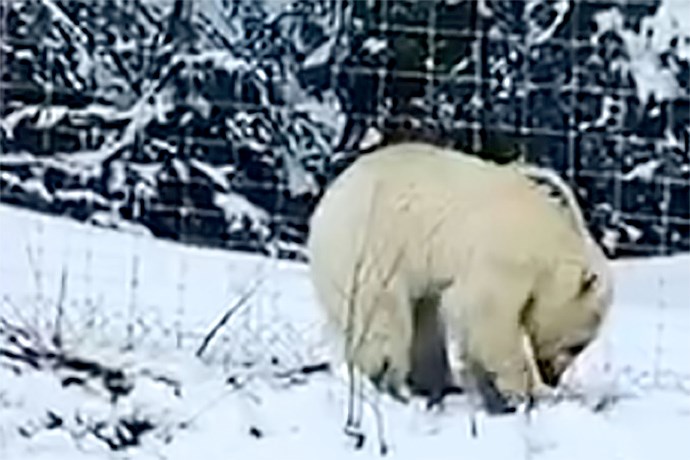FIELD, B.C. – A no-stopping zone has been put in place in Yoho National Park to give a rare white grizzly bear and its brown-coloured sibling a better chance of survival.
On Thursday (June 18), Parks Canada implemented a 10-kilometre no-stopping zone along the Trans-Canada Highway between Sherbrooke Creek near the B.C.-Alberta border and Field.
The two young grizzlies and several black bears are feeding on dandelions and other green-up on the side of the road, with the rare white bear causing many bear jams along that dangerous stretch of unfenced highway.
“We hope this informs visitors to travel through the area safely and to prevent these bears from getting hit on the highway,” said Jon Stuart-Smith, a wildlife management specialist for Lake Louise, Yoho and Kootenay.
Parks Canada and the RCMP will regularly patrol the no-stopping zone and have the ability to lay charges. Penalties range from a $115 on-the-spot ticket to a mandatory court appearance and maximum fine of up to $25,000.
Wildlife experts continue to try to haze the young grizzly bears away from the highway any chance they can.
“We want them to develop a behaviour of avoidance of humans, and especially vehicles and the highway at this point,” Stuart-Smith said.
“They’re just young bears trying to figure out how to make a living on the landscape, and haven’t had enough time to know they should be avoiding the highway and avoiding people.”
There have been many reports of unsafe parking and bear jams along that stretch of highway.
In addition, there was footage circulating on social media of the two young bears chasing a collared mountain goat across the busy road.
Stuart-Smith said the no-stopping zone will hopefully allow the bears to feed undisturbed and prevent traffic congestion that is dangerous for both bears and people.
“We have heard reports of people approaching them quite closely, which is disappointing and unfortunate,” he said.
“We haven’t had any reports that they have been fed at this point, which is good,” he added, noting that feeding wildlife in national parks is illegal.
It is hoped the two three-and-a-half- year-old grizzly bears will move away from the highway as natural food becomes more plentiful at higher elevations.
Although it is bear breeding season, Stuart-Smith said there hasn’t been any signs of larger males grizzlies in the area that would be a threat to the younger bears.
“It was a late spring and there is still snow in the high country and so that could be part of why they’re still persisting in the valley bottom,” he said.
“The safety measure will remain until bears move away from the highway as food becomes more plentiful at higher elevations.”
This is the second summer the three-and-half-year-old grizzlies are without their mother.
The two cubs showed up on their their own in spring 2019 at the site of a fatal train derailment and large grain spill that occurred earlier in the year near the Spiral Tunnels.
Stuart-Smith said the two young bears did get into grain last year, but it has since been cleaned up and Canadian Pacific Railway is rehabilitating and revegetating the site this summer.
“There’s nothing left to attract them and to keep them there, but it doesn’t mean they aren’t checking that area out because they did get that reward last spring,” he said.
“There are areas on that spill site where canola specifically is sprouting, but they don’t seem to to be keying in for the green vegetation from the canola; they seem to prefer the grasses.”
Parks Canada is also keeping a close eye on another rare coloured grizzly, a six-month old brown coloured cub with a white head and chest in neighbouring Banff and Kootenay national parks.
The grizzly cub have been seen with its sibling and mother feeding roadside.
Amy Krause, a spokesperson for Lake Louise, Yoho and Kootenay, said observing wildlife in their natural habitat is a privilege that comes with a responsibility to treat wildlife with the respect they deserve and need.
She said bears and other wildlife that become comfortable around people and roadsides are at greater risk of being struck by a vehicle.
“If you see wildlife near the highway, do not stop,” she said.
“When visitors see wildlife on other roads, stop only where legal and safe to do, stay in your vehicle and give the animal space.”
In neighbouring Jasper National Park, Parks Canada issued a notice of restriction for the first time this week preventing people from getting out of their vehicles when viewing wildlife anywhere in the park.
In place until at least July 9, the park-wide restriction is designed to give bears and other wildlife the space they need.
Meanwhile, outside of the 10-km no-stopping zone in Yoho National Park, Parks Canada asks people to consider not stopping for wildlife.
If you choose to do so:
- never feed wildlife;
- stay inside your vehicle;
- pull over only if it is safe to do so;
- pull all four wheels onto the shoulder;
- give bears more space than you think they need;
- be aware of the traffic around you, and
- move along quickly.
Parks Canada asks that any wildlife sightings, or reports of people violating the no-stopping zone, be called in to Banff dispatch at 403-762-1470.
Read more from RMOToday.com




